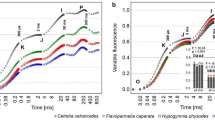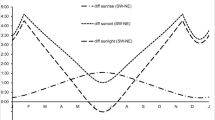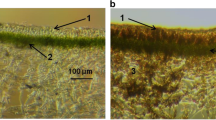Abstract
Over last decades, several studies have been focused on short-term high light stress in lichens under laboratory conditions. Such studies reported a strong photoinhibition of photosynthesis accompanied by a partial photodestruction of PSII, involvement of photoprotective mechanisms, and resynthetic processes into gradual recovery. In our paper, we applied medium [800 μmol(photon) m−2 s−1] light stress to induce negative changes in PSII funcioning as well as pigment and glutathione (GSH) content in two Antarctic fruticose lichen species. Chlorophyll (Chl) fluorescence parameters, such as potential and effective quantum yield of photosynthetic processes and fast transients (OJIP) recorded during high light exposition and recovery, revealed that Usnea antarctica was less susceptible to photoinhibition than U. aurantiaco-atra. This might be supported by a more pronounced high light-induced reduction in Chl a and b contents in U. aurantiaco-atra compared with U. antarctica. In both experimental species, total GSH showed an initial increase during the first 30–40 min of high light treatment followed by a decrease (60 min) and an increase during dark recovery. Full GSH recovery, however, was not finished in U. aurantiaco-atra even after 5 h indicating lower capacity of photoprotective mechanisms in the species. OJIP curves showed high light-induced decrease in both species, however, the recovery of the OJIPs shape to pre-photoinhibitory values was faster and more apparent in U. antarctica than in U. aurantiaco-atra. The results are discussed in terms of sensitivity of the two species to photoinhibition and their photosynthetic performance in natural environment.
Similar content being viewed by others
Abbreviations
- ABS/RC:
-
absorption of light energy per reaction centre
- DM:
-
dry mass
- ETo/RC:
-
photosynthetic electron transport rate per reaction centre
- Chl:
-
chlorophyll
- Fv/Fm :
-
potential quantum yield of PSII
- GSH:
-
glutathione
- GSSG:
-
glutathione, oxidized form
- OJIP:
-
fast chlorophyll fluorescence transients
- PI Abs:
-
performance index
- ROS:
-
reactive oxygen species
- TRo/RC:
-
trapping rate per reaction centre
- ΦPSII :
-
effective quantum yield of PSII
References
Barták, M.: Lichen photosynthesis. Scaling from the cellular to the organism level. — In: Hohmann-Marriott, M. (ed.): The Structural Basis of Biological Energy Generation. Advances in Photosynthesis and Respiration. Pp. 379–400. Springer, Dordrecht 2014.
Barták, M., Solhaug, K.-A., Vráblíková, H., Gauslaa, Y.: Curling during desiccation protects the foliose lichen Lobaria pulmonaria against photoinhibition. — Oecologia 149: 553–560, 2006.
Barták, M., Hájek, J., Očenášová, P.: Photoinhibition of photosynthesis in Antarctic lichen Usnea antarctica. I. Light intensity- and light duration-dependent changes in functioning of photosystem II. — Czech Polar Reports 2: 42–51, 2011.
Barták, M., Hájek, J., Vráblíková, H. et al.: High-light stress and photoprotection in Umbilicaria antarctica monitored by chlorophyll fluorescence imaging and changes in zeaxanthin and glutathione. — Plant Biol. 6: 333–341, 2004.
Barták, M., Vráblíková, H., Hájek, J.: Sensitivity of photosystem 2 of Antarctic lichens to high irradiance stress: Fluorometric study of fruticose (Usnea antarctica) and foliose (Umbilicaria decussata) species. — Photosynthetica 41: 497–504 2003.
Barták, M., Vráblíková-Cempírková, H., Štepigová, J. et al.: Duration of irradiation rather than quantity and frequency of high irradiance inhibits photosynthetic processes in the lichen Lasallia pustulata. — Photosynthetica 46: 161–169, 2008.
Bilger, W., Rimke, S., Schreiber, U. et al.: Inhibition of energytransfer to photosystem II in lichens by dehydration. — J. Plant Physiol. 134: 261–268, 1989.
Bjerke, J.W., Joly, D., Nilsen, L. et al.: Spatial trends in usnic acid concentrations of the lichen Flavocetraria nivalis along local climatic gradients in the Arctic (Kongsfjorden, Svalbard). — Polar Biol. 27: 409–417, 2004.
Bohuslavová, O.: Ecology of lichens on deglaciated parts of James Ross Island, the Antarctic. Ph.D. Thesis. Pp. 1–73. Masaryk University, Brno 2012.
Burrit, D.J., MacKenzie, S.: Antioxidant metabolism during acclimation of Begonia × erythrophylla to high light levels. — Ann. Bot. 91: 783–794, 2003.
Carreras, H.A., Wannaz, E.D., Perez, C.A. et al.: The role of urban air pollutants on the performance of heavy metal accumulation in Usnea amblyoclada. — Environ. Pollut. 97: 50–57, 2005.
Colville, L., Kranner, I.: Desiccation tolerant plants as model systems to study redox regulation of protein thiols. — Plant Growth Regul. 62: 241–255, 2010.
Davies, B.J., Glasser, N.F., Carrivick, J.L. et al.: Landscape evolution and ice-sheet behaviour in a semi-arid polar environment: James Ross Island, NE Antarctic Peninsula. — In: Hambrey, M.H., Barker, P.F., Barrett, P.J. et al. (ed.): Antarctic Palaeoenvironments and Earth-Surface Processes. Pp. 353–395. Geological Society, London 2013.
Del Hoyo, A., Álvarez, R., Del Campo, E.M. et al.: Oxidative stress induces distinct physiological responses in the two Trebouxia phycobionts of the lichen Ramalina farinacea. — Ann. Bot. 107: 109–118, 2011.
Demmig-Adams, B., Maguas, C., Adams, W.W. et al.: Effect of high light on the efficiency of photochemical energyconversion in a variety of lichen species with green and bluegreen phycobionts. — Planta 180: 400–409, 1990.
Hauck, M., Dulamsuren, C., Mühlenberg, M.: Lichen diversity on steppe slopes in the northern Mongolian mountain taiga and its dependence on microclimate. — Flora 202: 530–546, 2007.
Heber, U., Azarkovich, M., Shuvalov, V.: Activation of mechanisms of photoprotection by desiccation and by light: poikilohydric photoautotrophs. — J. Exp. Bot. 58: 2745–2759, 2007.
Holm, G.: Chlorophyll mutations in barley. — Acta Agr. Scand. 4: 457–471, 1954.
Huneck, S.: Progress in the chemistry of lichen substances, 2000–2005. — J. Hattori Bot. Lab. 100: 671–694, 2006.
Kappen L., Breuer M., Bölter M.: Ecological and physiological investigations in continental antarctic cryptogams. 3. Photosynthetic production of Usnea sphacelata: diurnal courses, models, and the effect of photoinhibition. — Polar Biol. 11: 393–402, 1991.
Košler, J., Magna, T., Mlčoch, B. et al.: Combined Sr, Nd, Pb, and Li isotope geochemistry of alkaline lavas from northern James Ross Island (Antarctic Peninsula) and implications for back-arc magma formation. — Chem. Geol. 258: 207–218, 2009.
Krábková, G.: [Content of UV-absorbing compounds and pigments in extracts from lichens from different Earth regions.] Pp. 1–67. Diploma Thesis. Masaryk University, Brno 2013. [In Czech]
Kranner, I.: Determination of glutathione, glutathione disulphide and two related enzymes, glutathione reductase and glucose-6-phosphate dehydrogenase, in fungal and plant cells. — In: Varma, A. (ed.): Mycorrhiza Manual. Pp. 227–241. Springer, Berlin 1998.
Kranner, I.: Glutathione status correlates with different degrees of desiccation tolerance in three lichens. — New Phytol. 154: 451–460, 2002.
Kranner, I., Birtić, S.: A modulating role for antioxidants in desiccation tolerance. — Integr. Comp. Biol. 45: 734–740, 2005.
Kranner, I., Cram, W.J., Zorn, M. et al.: Antioxidants and photoprotection in a lichen as compared with its isolated symbiotic partners. — P. Natl. Acad. Sci. USA 102: 3141–3146, 2005.
Láska, K., Barták, M., Hájek, J. et al.: Climatic and ecological characteristics of deglaciated area of James Ross Island, Antarctica, with a special respect to vegetation cover. — Czech Polar Reports 1: 49–62, 2011.
Manrique, E., Balaguer, L., Barnes, J. et al.: Photoinhibition studies in lichens using chlorophyll fluorescence analysis. — Bryologist 96: 443–449, 1993.
May, M.J., Vernoux, T., Leaver, C. et al.: Glutathione homeostasis in plants: implications for environmental sensing and plant development. — J. Exp. Bot. 49: 649–667, 1998.
Mrak, T., Jeran, Z., Batič, F. et al.: Arsenic accumulation and thiol status in lichens exposed to As(V) in controlled conditions. — Biometals 23: 207–219, 2010.
Müller, M., Zechmann, B., Zellnig, G.: Ultrastructural localization of glutathione in Cucurbita pepo plants. — Protoplasma 223: 213–219, 2004.
Noctor, G., Foyer, C.H.: Ascorbate and glutathione: Keeping active oxygen under control. — Annu. Rev. Plant Phys. 49: 249–279, 1998.
Noctor, G., Gomez, L., Vanacker, H. et al.: Interactions between biosynthesis, compartmentation and transport in the control of glutathione homeostasis and signalling. — J. Exp. Bot. 53: 1283–1304, 2002.
Onofri, S., Fenice, M., Cicalini, A.R. et al.: Ecology and biology of microfungi from Antarctic rocks and soils. — Ital. J. Zool. 67: 163–167, 2000.
Palmqvist, K., Dahlman, L., Valladares, F. et al.: CO2 exchange and thallus nitrogen across 75 contrasting lichen associations from different climate zones. — Oecologia 133: 295–306, 2002.
Rausch, T., Wachter, A.: Sulfur metabolism: a versatile platform for launching defence operations. — Trends Plant Sci. 10: 503–509, 2005.
Riddell, J., Padgett, P.E., Nash III, T.H.: Physiological responses of lichens to factorial fumigations with nitric acid and ozone. — Environ. Pollut. 170: 202–210, 2012.
Rikkinen, J.: What’s Behind the Pretty Colours. A Study on the Photobiology of Lichens. Edition 4: Bryobrothera. Pp. 239, The Finnish Bryological Society, Helsinki 1995.
Singh, J., Dubey, A.K., Singh, R.P.: Antarctic terrestrial ecosystem and role of pigments in enhanced UV-B radiations. — Rev. Environ. Sci. Biotechnol. 10: 63–77, 2011.
Singh, R., Ranjan, S., Nayaka, S. et al.: Functional characteristics of a fruticose type of lichen, Stereocaulon foliolosum Nyl., in response to light and water stress. — Acta Physiol. Plant. 35: 1605–1615, 2013.
Smellie, J.L., Johnson, J.S., McIntosh, W.C. et al.: Six million years of glacial history recorded in volcanic lithofacies of the James Ross Island Volcanic Group, Antarctic Peninsula. — Palaeogeogr. Palaeoclimatol. Palaeoecol. 260: 122–148, 2008.
Štepigová, J., Vráblíková, H., Lang, J. et al.: Glutathione and zeaxanthin formation during high light stress in foliose lichens. — Plant Soil Environ. 53: 340–344, 2007.
Stirbet, A.: Excitonic connectivity between photosystem II units: what is it, and how to measure it? — Photosynth. Res. 116: 189–214, 2013.
Strasser, R.J., Shrivastava, A., Tsimilli-Michael, M.: The fluorescence transient as a tool to characterize and screen photosynthetic samples. — In: Yunus, M., Pathre, U., Mohanty, P. (ed): Probing Photosynthesis: Mechanisms, Regulation and Adaptation. Pp. 445–483. Taylor and Francis, London 2000.
Szalai, G., Kellös, T., Galiba, G. et al.: Glutathione as an antioxidant and regulatory molecule in plants under abiotic stress conditions. — Plant Growth Regul. 28: 66–80, 2009.
Tausz, M.: The role of glutathione in plant response and adaptation to natural stress. — In: Grill, D., Tausz, M., De Kok, L.J.: Significance of Glutathione to Plant Adaptation to the Environment. Pp. 101–122. Springer, Dordrecht 2001.
Terauds, A., Chown, S.L., Morgan, F. et al.: Conservation biogeography of the Antarctic. — Diversity Distrib. 18: 726–741, 2012.
Tretiach, M., Baruffo, L., Piccotto, M.: Effects of Mediterranean summer conditions on chlorophyll a fluorescence emission in the epiphytic lichen Flavoparmelia soredians: a field study. — Plant Biosyst. 146: 171–180, 2012.
Veerman, J., Vasil’ev, S., Paton, G.D. et al.: Photoprotection in the lichen Parmelia sulcata: The origins of desiccation-induced fluorescence quenching. — Plant Physiol. 145: 997–1005, 2007.
Vráblíková, H., Barták, M., Wönisch, A.: Changes in glutathione and xanthophyll cycle pigments in the high light-stressed lichens Umbilicaria antarctica and Lassalia pustulata. — J. Photoch. Photobiol. B 79: 35–41, 2005.
Wendler, J., Holzwarth, A.R.: State transitions in the green alga Scenedesmus obliquus probed by time-resolved chlorophyll fluorescence spectroscopy and global data analysis. — Biophys. J. 52: 717–728, 1987.
Author information
Authors and Affiliations
Corresponding author
Additional information
Acknowledgements: The authors thank the infrastructure of the CzechPolar project for providing field and laboratory facilities that enabled this study. The authors are grateful to Peter Vaczi for his help with statistical analysis.
Rights and permissions
About this article
Cite this article
Balarinová, K., Barták, M., Hazdrová, J. et al. Changes in photosynthesis, pigment composition and glutathione contents in two Antarctic lichens during a light stress and recovery. Photosynthetica 52, 538–547 (2014). https://doi.org/10.1007/s11099-014-0060-7
Received:
Accepted:
Published:
Issue Date:
DOI: https://doi.org/10.1007/s11099-014-0060-7




